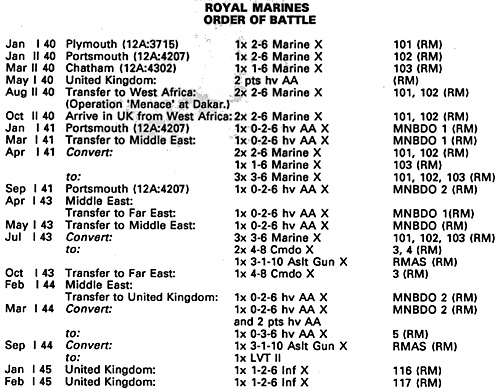The first Commando units were all Army units. However by 1943 senior Naval and Marine officers were concerned with the dominance of the Army in what was traditionally the sphere of activity of the Senior Service (shades of US Service rivalry!). The junior officers were disgruntled by the lack of action and jumped at the chance of becoming involved in the high profile Commando role.
It is probably no coincidence that the Chief of Combined Operations at the time - Mountbatten was a Naval officer. So the existing infantry battalions were reformed as Royal Marine Commandos (each Commando some 500 men in strength) numbered from 40 to 48. Two Brigade HQ's were used to create Headquarters, the 102 X converting to the 3rd and the 101 X to the 4th, while the 103 X was disbanded. Originally the new formations were called Special Service or SS Brigades, but the connotations of the initials "SS" led to a quick rename as "Commando Brigade"!
Purists should note that there were a total of four of these brigades, all made up of a mixture of Army and Marine Commandos. I have chosen the 3rd and 4th as being "Marine" to reflect their origin, and the fact that, by coincidence, these particular formations contained a majority of Marine units. For Grand Europa purposes one of these brigades (it happened to be the 3rd) must be withdrawn in Oct 1943 for service in the Far East. Of the remainder, the 1st and 4th served in NW Europe, the 2nd in the Mediterranean.
One other Marine unit needs to be shown at Europa scale. This is the Armoured Support Brigade formed to provide fire-support in amphibious landings. The formation actually represents five batteries each equipped with 16 Centaur tanks. The Centaur was a Cromwell medium tank with its 75mm gun replaced by a 94mm howitzer. I am not sure how this should be represented in Europa terms - perhaps as a commando assault gun brigade. (After all, British Commando Tanks seems just as logical as German Parachute Panzers!)
Remember these are NOT amphibious tanks, but they were trained to fire and disembark under fire from landing craft. In effect they are simply assault guns. The formation date for this unit is earlier than the historical one (March 1944). There are two reasons.
First, most of the men came from the assets of the brigades disbanded or converted to form the Commandos. Secondly, the historic date was driven by the decision to launch "Overlord" in 1944. Second Front would permit an earlier invasion, in which case the Armoured Support Brigade would form at the same time as the Commandos. After the Normandy landing the unit was disbanded to provide crews for landing craft and specialised armour for the LVTs.
There were a few other Marine units. In 1945, two weak brigades, the 116 and 117 were formed from training units and sent to France. The Marines also manned some of the heavy coast artillery established in 1940-41. One battery manned the two 14" guns at Dover, a second three 13.5" railroad guns operating in the southeast. These have not been included in the OB, pending definitive Europa rules on coast defense artillery. There is no required listing for the most famous of Marine units - the Special Boat Service. This is because during our period it was an Army unit, and was only 'acquired' by the Marines in 1946.
To bring the story up to date: In restrospect the idea of converting Marines to Commandos was an inspired one, which perhaps saved the Corps from extinction in the massive post-war defense cuts. For the Army Commandos were disbanded, leaving the Marines with a viable and welldefined role. Today their personnel strength is almost identical to that in 1939 - with three commando battalions, a support battalion and a helicopter squadron.
Some unsympathetic Europa player might wonder at all this fuss and description over a contingent with no more than FIVE counters in play at one time. But surely the Real Marines deserve as much attention in Europa as, let's say, the Slovakian Army!

The Royal Marines Missing Europa Units:
Back to Europa Number 15 Table of Contents
Back to Europa List of Issues
Back to MagWeb Master Magazine List
© Copyright 1990 by GR/D
This article appears in MagWeb (Magazine Web) on the Internet World Wide Web. Other military history articles and gaming articles are available at http://www.magweb.com